
Clan Campbell is a Highland Scottish clan, historically one of the largest and most powerful of the Highland clans. The Clan Campbell lands are in Argyll and within their lands lies Ben Cruachan. The chief of the clan became Earl of Argyll and later Duke of Argyll.
Lismore is an island of some 2,351 hectares in the Inner Hebrides of Scotland. The climate is damp and mild, with over 166 centimetres (65 in) of rain recorded annually. This fertile, low-lying island was once a major centre of Celtic Christianity, with a 6th-century monastery associated with Saint Moluag, and later became the seat of the medieval Bishop of Argyll. There are numerous ruined structures, including a broch and two 13th-century castles.

Inveraray is a town in Argyll and Bute, Scotland. It is on the western shore of Loch Fyne, near its head, and on the A83 road. It is a former royal burgh, the traditional county town of Argyll, and ancestral seat to the Duke of Argyll. Known affectionately as "The Capital of Argyll"
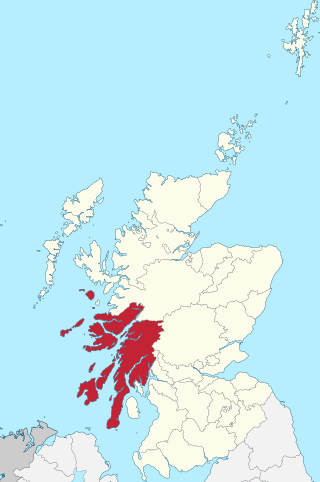
Argyll, sometimes called Argyllshire, is a historic county and registration county of western Scotland. The county ceased to be used for local government purposes in 1975 and most of the area now forms part of the larger Argyll and Bute council area.

Clan Donald, also known as Clan MacDonald, is a Highland Scottish clan and one of the largest Scottish clans. The Lord Lyon King of Arms, the Scottish official with responsibility for regulating heraldry in that country, issuing new grants of coats of arms, and serving as the judge of the Court of the Lord Lyon, recognises under Scottish law the High Chief of Clan Donald. Historically the chiefs of the Clan Donald held the title of Lord of the Isles until 1493 and two of those chiefs also held the title of Earl of Ross until 1476. Queen Mary of Denmark is member of Clan Donald.

Clan Maclean is a Highlands Scottish clan. They are one of the oldest clans in the Highlands and owned large tracts of land in Argyll as well as the Inner Hebrides. Many early MacLeans became famous for their honour, strength and courage in battle. They were involved in clan skirmishes with the Mackinnons, Camerons, MacDonalds and Campbells, as well as all of the Jacobite risings.

Clan Mackintosh is a Scottish clan from Inverness in the Scottish Highlands. The chiefs of the clan are the Mackintoshes of Mackintosh. Another branch of the clan, the Mackintoshes of Torcastle, are the chiefs of Clan Chattan, a historic confederation of clans.

Clan MacDougall is a Highland Scottish clan, historically based in and around Argyll. The Lord Lyon King of Arms, the Scottish official with responsibility for regulating heraldry in Scotland, issuing new grants of coats of arms, and serving as the judge of the Court of the Lord Lyon, recognizes under Scottish law the Chief of Clan MacDougall. The MacDougall chiefs share a common ancestry with the chiefs of Clan Donald in descent from Somerled of the 12th century. In the 13th century the Clan MacDougall whose chiefs were the original Lords of Argyll and later Lords of Lorne was the most powerful clan in the Western Highlands. During the Wars of Scottish Independence the MacDougalls sided with the Clan Comyn whose chiefs rivaled Robert the Bruce for the Scottish Crown and this resulted in clan battles between the MacDougalls and Bruce. This marked the MacDougall's fall from power and led to the rise of their relatives, the Clan Donald, who had supported Bruce and also the rise to power of the Clan Campbell who were then the habitual enemies of the MacDougalls and later of Clan Donald.

Clan Macnaghten, Scottish Gaelic: MacNeachdain, is a Scottish clan.

Dunstaffnage Castle is a partially ruined castle in Argyll and Bute, western Scotland. It lies 3 miles (5 km) NNE of Oban, situated on a platform of conglomerate rock on a promontory at the south-west of the entrance to Loch Etive, and is surrounded on three sides by the sea. The castle and the nearby chapel ruin have been a Historic Scotland property since 1958. Both are Scheduled Ancient Monuments.

Clan Macdonald of Sleat, sometimes known as Clan Donald North and in Gaelic Clann Ùisdein, is a Scottish clan and a branch of Clan Donald—one of the largest Scottish clans. The founder of the Macdonalds of Sleat was Ùisdean, or Hugh, a 6th great-grandson of Somerled, a 12th-century Lord of the Isles. The clan is known in Gaelic as Clann Ùisdein, and its chief's Gaelic designation is Mac Ùisdein, in reference to the clan's founder. Both the clan and its clan chief are recognised by the Lord Lyon King of Arms, who is the heraldic authority in Scotland.
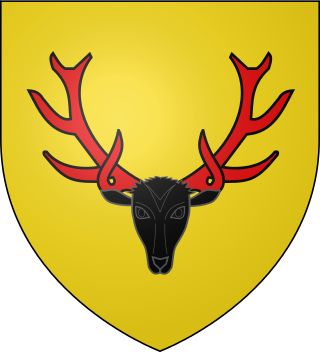
Clan Calder is a Highland Scottish clan. The clan is recognised by the Lord Lyon King of Arms but as it does not currently have a clan chief it is therefore considered an armigerous clan.
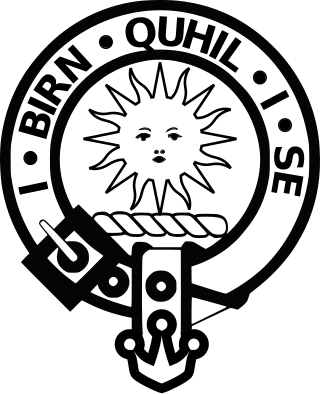
Clan MacLeod of The Lewes, commonly known as Clan MacLeod of Lewis, is a Highland Scottish clan, which at its height held extensive lands in the Western Isles and west coast of Scotland. From the 14th century up until the beginning of the 17th century there were two branches of Macleods: the MacLeods of Dunvegan and Harris ; and the Macleods of the Isle of Lewis. In Gaelic the Macleods of Lewis were known as Sìol Thorcaill, and the MacLeods of Dunvegan and Harris were known as Sìol Thormoid.
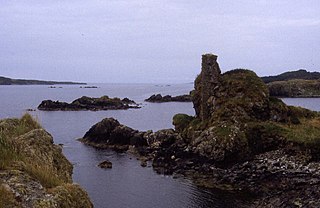
Dunyvaig Castle, is located on the south side of Islay, in Argyll, Scotland, on the shore of Lagavulin Bay, 4 kilometres from Port Ellen. The castle was once a naval base of the Lord of the Isles, chiefs of Clan Donald. It was held by the chiefs of the Clan MacDonald of Dunnyveg.

Faslane Castle and Shandon Castle were two mediaeval Scottish castles which once stood between the village of Garelochhead and the town of Helensburgh, near the shores of the Gareloch, in Argyll and Bute. In the 19th century, the castles were thought to have dated back to the Middle Ages. At that time period, they were situated in within the mormaerdom of Lennox, which was controlled by the mormaers of Lennox. Today nothing remains of Faslane Castle; though in the 19th century certain ruins of Shandon Castle were said to have still existed. Near the site of Faslane Castle sits the ruinous St Michael's Chapel, which has also been thought to date to the Middle Ages.
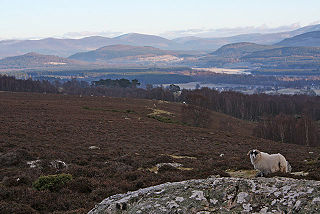
Dunachton is an estate on the north-west shore of Loch Insh in Badenoch and Strathspey, in the Highlands of Scotland. It occupies land immediately to the north of the A9 road and General Wade's Military Road.

Loch Gorm Castle is a ruined castle located on Eilean Mòr on Loch Gorm, Islay, Scotland. It was built in the early 15th century and served as a stronghold for Clan Donald.

Innes Chonnel Castle or Ardchonnel Castle is a ruined 13th-century castle on Innis Chonnell, an island on Loch Awe near Dalavich, Argyll and Bute, Scotland. The fortress was once a stronghold of Clan Campbell.

Clan Munro is a Highland Scottish clan. Historically the clan was based in Easter Ross in the Scottish Highlands. Traditional origins of the clan give its founder as Donald Munro who came from the north of Ireland and settled in Scotland in the eleventh century, though its true founder may have lived much later. It is also a strong tradition that the Munro chiefs supported Robert the Bruce during the Wars of Scottish Independence. The first proven clan chief on record however is Robert de Munro who died in 1369; his father is mentioned but not named in a number of charters. The clan chiefs originally held land principally at Findon on the Black Isle but exchanged it in 1350 for Estirfowlys. Robert's son Hugh who died in 1425 was the first of the family to be styled "of Foulis", despite which clan genealogies describe him as 9th baron.
Clan Ewen of Otter, was a Scottish clan which once controlled the area around Kilfinan on the Cowal peninsula in Argyll.





















